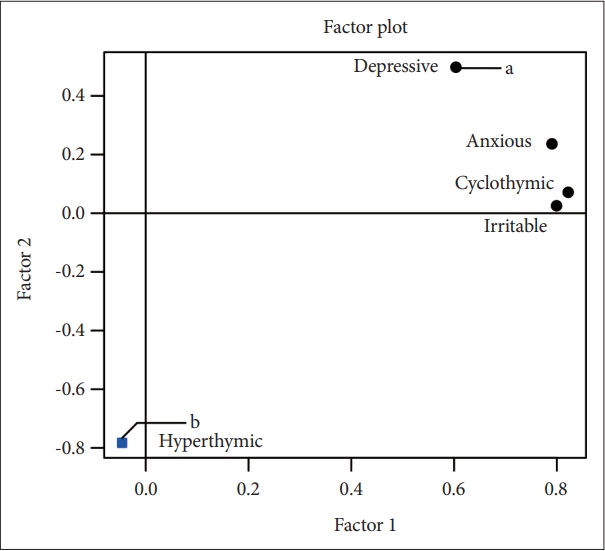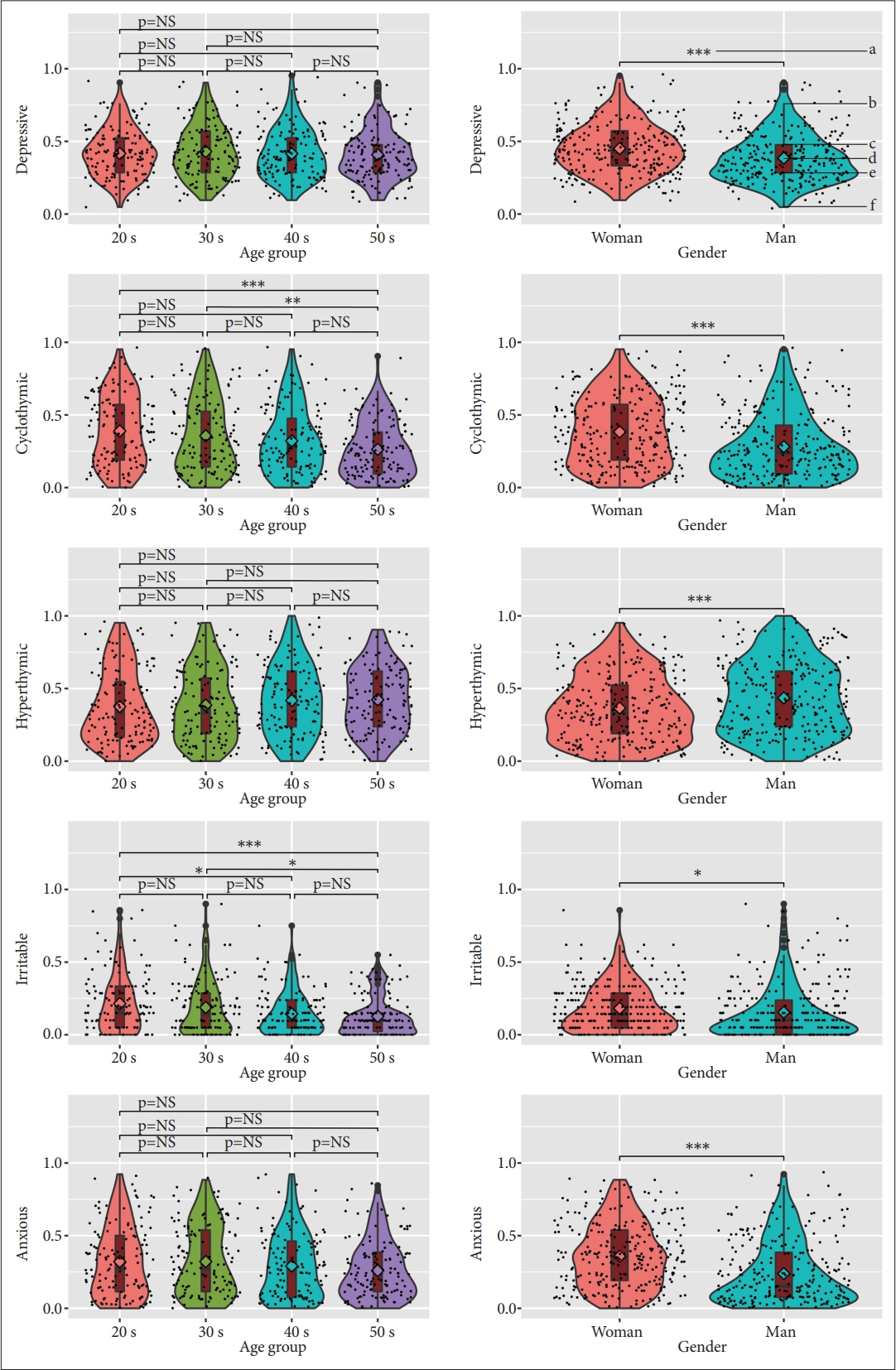1. American Psychological Association. Humoral Theory. American Psychological Association, APA Dictionary of Psychology; 2020.
2. Kraepelin E. Manic-depressive insanity and paranoia. Edinburgh: E. & S. Livingstone; 1921.
3. Akiskal HS, Mendlowicz MV, Jean-Louis G, Rapaport MH, Kelsoe JR, Gillin JC, et al. TEMPS-A: validation of a short version of a self-rated instrument designed to measure variations in temperament. J Affect Disord 2005;85:45-52.


4. Akiskal HS, Akiskal KK, Haykal RF, Manning JS, Connor PD. TEMPSA: progress towards validation of a self-rated clinical version of the temperament evaluation of the Memphis, Pisa, Paris, and San Diego autoquestionnaire. J Affect Disord 2005;85:3-16.


5. Akiskal HS, Akiskal K, Allilaire JF, Azorin JM, Bourgeois ML, Sechter D, et al. Validating affective temperaments in their subaffective and socially positive attributes: psychometric, clinical and familial data from a French national study. J Affect Disord 2005;85:29-36.


6. Dembi ńska-Krajewska D, Rybakowski J. [The temperament evaluation of Memphis, Pisa and San Diego autoquestionnaire (TEMPS-A)--an important tool to study affective temperaments]. Psychiatr Pol 2014;48:261-276. Polish.

7. Krebs MO, Kazes M, Olié JP, Loo H, Akiskal K Akiskal H. The French version of the validated short TEMPS-A: the temperament evaluation of Memphis, Pisa, Paris and San Diego. J Affect Disord 2006;96:271-273.


8. Borkowska A, Rybakowski JK, Drozdz W, Bielinski M, Kosmowska M, Rajewska-Rager A, et al. Polish validation of the TEMPS-A: the profile of affective temperaments in a college student population. J Affect Disord 2010;123:36-41.


9. Pompili M, Girardi P, Tatarelli R, Iliceto P, De Pisa E, Tondo L, et al. TEMPS-A (Rome): psychometric validation of affective temperaments in clinically well subjects in mid- and south Italy. J Affect Disord 2008;107:63-75.


10. Karam EG, Mneimneh Z, Salamoun M, Akiskal KK, Akiskal HS. Psychometric properties of the Lebanese-Arabic TEMPS-A: a national epidemiologic study. J Affect Disord 2005;87:169-183.


12. Matsumoto S, Akiyama T, Tsuda H, Miyake Y, Kawamura Y, Noda T, et al. Reliability and validity of TEMPS-A in a Japanese non-clinical population: application to unipolar and bipolar depressives. J Affect Disord 2005;85:85-92.


13. Lin K, Xu G, Miao G, Ning Y, Ouyang H, Chen X, et al. Psychometric properties of the Chinese (Mandarin) TEMPS-A: a population study of 985 non-clinical subjects in China. J Affect Disord 2013;147:29-33.


14. Figueira ML, Caeiro L, Ferro A, Severino L, Duarte PM, Abreu M, et al. Validation of the temperament evaluation of Memphis, Pisa, Paris and San Diego (TEMPS-A): Portuguese-Lisbon version. J Affect Disord 2008;111:193-203.


16. Nowakowska C, Strong CM, Santosa CM, Wang PW, Ketter TA. Temperamental commonalities and differences in euthymic mood disorder patients, creative controls, and healthy controls. J Affect Disord 2005;85:207-215.


17. Strong CM, Nowakowska C, Santosa CM, Wang PW, Kraemer HC, Ketter TA. Temperament-creativity relationships in mood disorder patients, healthy controls and highly creative individuals. J Affect Disord 2007;100:41-48.


18. Vázquez GH, Kahn C, Schiavo CE, Goldchluk A, Herbst L, Piccione M, et al. Bipolar disorders and affective temperaments: a national family study testing the “endophenotype” and “subaffective” theses using the TEMPS-A Buenos Aires. J Affect Disord 2008;108:25-32.


21. Rybakowski JK, Dembinska D, Kliwicki S, Akiskal KK, Akiskal HH. TEMPS-A and long-term lithium response: positive correlation with hyperthymic temperament. J Affect Disord 2013;145:187-189.


23. Vázquez GH, Gonda X, Lolich M, Tondo L, Baldessarini RJ. Suicidal risk and affective temperaments, evaluated with the TEMPS-A scale: a systematic review. Harv Rev Psychiatry 2018;26:8-18.


24. Hulin C, Netemeyer RG, Cudeck R. Can a reliability coefficient be too high? Journal of Consumer Psychology 2001;10:55-58.

25. Blöink R, Brieger P, Akiskal HS, Marneros A. Factorial structure and internal consistency of the German TEMPS-A scale: validation against the NEO-FFI questionnaire. J Affect Disord 2005;85:77-83.


26. Fountoulakis KN, Siamouli M, Magiria M, Pantoula E, Moutou K, Kemeridou M, et al. Standardization of the TEMPS-A in the Greek general population. J Affect Disord 2014;158:19-29.


27. Rózsa S, Rihmer Z, Gonda X, Szili I, Rihmer A, Ko N, et al. A study of affective temperaments in Hungary: internal consistency and concurrent validity of the TEMPS-A against the TCI and NEO-PI-R. J Affect Disord 2008;106:45-53.


28. Vázquez GH, Nasetta S, Mercado B, Romero E, Tifner S, Ramón Mdel L, et al. Validation of the TEMPS-A Buenos Aires: Spanish psychometric validation of affective temperaments in a population study of Argentina. J Affect Disord 2007;100:23-29.


29. Akiskal HS, Akiskal KK. TEMPS: Temperament evaluation of Memphis, Pisa, Paris and San Diego. J Affect Disord 2005;85:1-2.


30. Chiaroni P, Hantouche EG, Gouvernet J, Azorin JM, Akiskal HS. The cyclothymic temperament in healthy controls and familially at risk individuals for mood disorder: endophenotype for genetic studies? J Affect Disord 2005;85:135-145.


31. Kesebir S, Vahip S, Akdeniz F, Yüncü Z, Alkan M, Akiskal H. Affective temperaments as measured by TEMPS-A in patients with bipolar I disorder and their first-degree relatives: a controlled study. J Affect Disord 2005;85:127-133.


32. Maser JD, Cloninger CR. Comorbidity of Mood and Anxiety Disorders. Washington: American Psychiatric Press; 1990.
33. Evans L, Akiskal HS, Keck PE Jr, McElroy SL, Sadovnick AD, Remick RA, et al. Familiality of temperament in bipolar disorder: support for a genetic spectrum. J Affect Disord 2005;85:153-168.


34. American Psychiatric Association. Diagnostic and Statistical Manual of Mental Disorders. 5th ed. Washington: American Psychiatric Association; 2013.
35. Walsh MA, Royal AM, Barrantes-Vidal N, Kwapil TR. The association of affective temperaments with impairment and psychopathology in a young adult sample. J Affect Disord 2012;141:373-381.


36. Walsh MA, Brown LH, Barrantes-Vidal N, Kwapil TR. The expression of affective temperaments in daily life. J Affect Disord 2013;145:179-186.


37. Stringaris A, Taylor E. Disruptive mood: irritability in children and adolescents. London: Oxford University Press; 2015.
38. Akiskal HS, Placidi GF, Maremmani I, Signoretta S, Liguori A, Gervasi R, et al. TEMPS-I: delineating the most discriminant traits of the cyclothymic, depressive, hyperthymic and irritable temperaments in a nonpatient population. J Affect Disord 1998;51:7-19.


39. Akiskal HS, Akiskal KK, Perugi G, Toni C, Ruffolo G, Tusini G. Bipolar II and anxious reactive “comorbidity”: toward better phenotypic characterization suitable for genotyping. J Affect Disord 2006;96:239-247.


40. Syrstad VEG, Oedegaard KJ, Fasmer OB, Halmoy A, Haavik J, Dilsaver S, et al. Cyclothymic temperament: associations with ADHD, other psychopathology, and medical morbidity in the general population. J Affect Disord 2020;260:440-447.


45. Akiskal KK, Akiskal HS. The theoretical underpinnings of affective temperaments: implications for evolutionary foundations of bipolar disorder and human nature. J Affect Disord 2005;85:231-239.


46. Gonda X, Rihmer Z, Zsombok T, Bagdy G, Akiskal KK, Akiskal HS. The 5HTTLPR polymorphism of the serotonin transporter gene is associated with affective temperaments as measured by TEMPS-A. J Affect Disord 2006;91:125-131.


47. Cuddy AJ, Wolf EB, Glick P, Crotty S, Chong J, Norton MI. Men as cultural ideals: Cultural values moderate gender stereotype content. J Pers Soc Psychol 2015;109:622-635.


48. Kim JW, Lee HK, Lee K. Influence of temperament and character on resilience. Compr Psychiatry 2013;54:1105-1110.


49. Gonda X, Vázquez GH, Akiskal KK, Akiskal HS. From putative genes to temperament and culture: cultural characteristics of the distribution of dominant affective temperaments in national studies. J Affect Disord 2011;131:45-51.


50. Kryla-Lighthall N, Mather M. The role of cognitive control in older adults’ emotional well-being. In: Berngtson V, Gans D, Putney N, Silverstein , editor. Handbook of Theories of Aging. New York: Springer Publishing, 2009, p. 323-344.
51. Orgeta V. Specificity of age differences in emotion regulation. Aging Ment Health 2009;13:818-826.


52. Lee J, Min SK, Kim KH, Kim B, Cho SJ, Lee SH, et al. Differences in temperament and character dimensions of personality between patients with Hwa-byung, an anger syndrome, and patients with major depressive disorder. J Affect Disord 2012;138:110-116.













